Kitchen floors: types, choices, interesting solutions
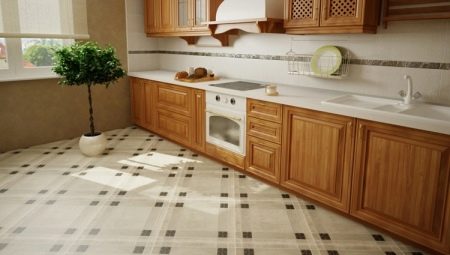
The floors in the kitchen are the most important component of a high-quality finish, a guarantee of comfort and a kind of designer's business card. It is the floor covering that is seen by guests who come to the house for the first time, and people living in the apartment. Modern kitchens allow for a variety of stylistic solutions, but flooring has its own requirements to ensure safety, facilitate cleaning and ensure the durability of the chosen decor.
The choice of options available allows you to meet almost any budget. Self-leveling, cork, tiles and laminate combined, polymer and marble, wooden floors and their variants from other materials have an attractive appearance and, under certain conditions, are suitable for use in the kitchen. How do you make the final decision and choose the best coverage option? To begin with, it is worth considering all their features in as much detail as possible.
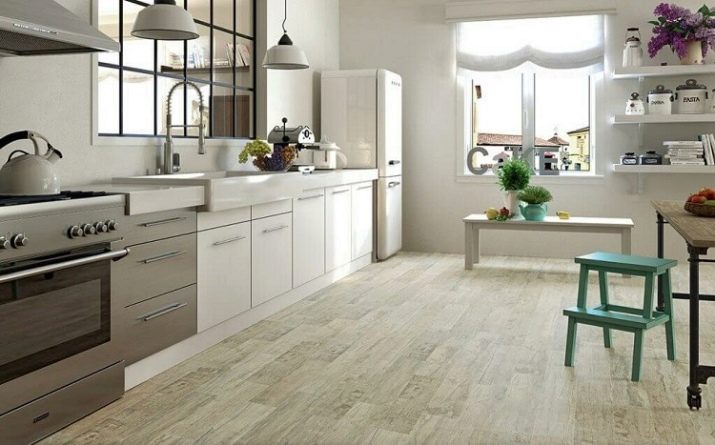
Coating options
The floor in the kitchen must have a certain set of properties that will allow it to easily withstand contact with hot and cold objects, mechanical damage and intense stress. The ideal coating is one that easily withstands changes in temperature and humidity, is easy to clean, and lasts a long time. In addition, the aesthetics of the selected material is also important - it must be in harmony with the general style of the interior, have a presentable appearance, and create a certain mood in the space of the room.
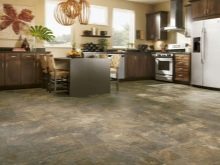
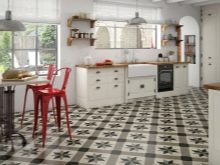
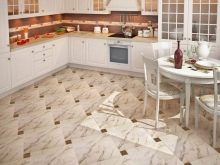
Bulk
Liquid self-leveling or polymer floors have gained popularity both in the commercial interiors for which they were originally developed, and in the living spaces of houses and apartments. Instead of laying the coating on the prepared base, in this case, the material is poured. It can be based on epoxy or polyurethane polymer, methyl methacrylate or cement-acrylic compound.
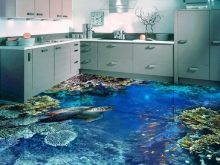
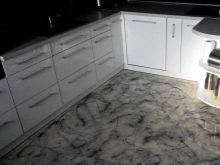

The finished coating is transparent, but can be painted with additional components in the composition. The floors are made with photo printing and original ornaments, the decor can be fancy, for example, with filling the coating with natural materials or any other elements - from coins and shells to artificial flowers. This way you can get a completely unique decor.
The only drawback is that the flooring technology is complex, requires a professional approach and a significant investment of time.
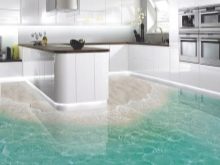
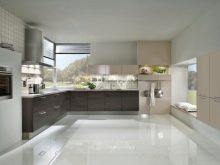

Combined tile and laminate
For kitchen flooring, the tile / laminate combination is the most popular. This finishing option is distinguished by high reliability and functionality, is inexpensive, and allows you to effectively zone the space when creating complex interiors. Practical moisture resistant tiles are usually installed in the "wet" area of the kitchen. Ceramic or porcelain stoneware is used as a material, laid in a sector along the headset cabinets.
It is very important to use non-slip tile options with a rough surface.

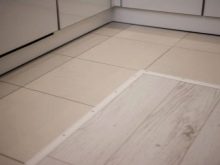
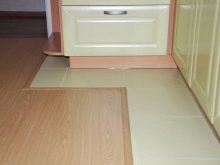
Outside the sanitary zone, a laminate floor is installed. Coatings with a high level of wear resistance should be selected. Among the advantages of such a solution, one can note the absence of problems with pushing through softer floor materials with furniture legs, functionality, and ease of cleaning. The joint between floor elements of different structure is closed with a decorative strip or overlay; you can also equip a podium in this area. Combinations can be contrasting or matched in the same range of colors and textures.
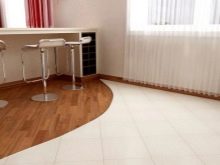
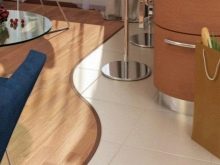
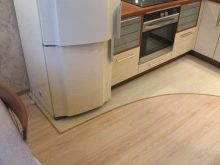
Suberic
Cork flooring has ceased to be exotic in the interior of modern kitchens. This finish looks impressive, has a pleasant texture, is strong and durable. Environmentally friendly material does not emit hazardous substances into the atmosphere, has a unique pattern, but needs a protective varnish coating. The cork oak from which the floor is made has an antistatic effect, suitable for rooms where people with asthma or allergies to dust live.
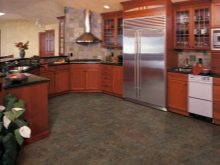


Ready-made lamellas, on which the array is cut, are easy to fit, such a floor does not require additional insulation. The coating has a high level of noise insulation, which is important for the kitchen.
When properly treated with protective varnish, the material does not absorb odors.
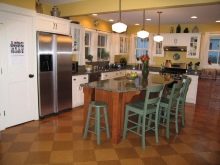
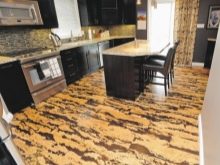
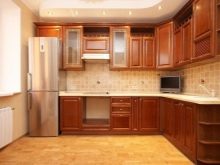
Linoleum
Natural or made on an artificial basis (PVC) material is widely used in kitchen decoration in economy class cottages and apartments. Its practicality is highly regarded, and the variety of design options allows you to achieve harmony in the design of the room. But not without drawbacks. Linoleum, especially artificial linoleum, burns well; upon contact with a fallen match, traces will definitely remain on it. It is quite soft, so over time, the surface will sag slightly under the weight of the furniture. In addition, in terms of the degree of abrasion, most of these materials are much inferior to other options - laminate, board, stone, tile.
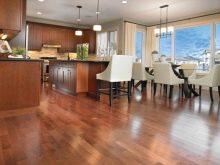
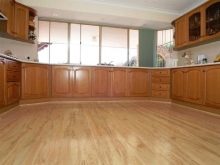
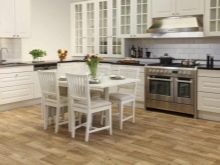
Bamboo
A unique design option for flooring. Bamboo floor coverings are now available in three varieties - plank, parquet or tile. The characteristics of the material are such that it is suitable for rooms with different levels of traffic. A durable floor made of this natural covering is characterized by increased resistance to wear and tear, it is not afraid of moisture, is fireproof, and looks spectacular.
For the production of bamboo tiles, parquet or planks, the fibers are glued together and pressed, forming a base that is not inferior in its characteristics to solid wood. The color scale of the material ranges from straw yellow to coffee. The planks on the floor are mounted in a groove, produced with a ready-made lock connection, which allows you to quickly and efficiently mount the coating.
In general, bamboo can be a good alternative to natural wood in kitchen finishes.
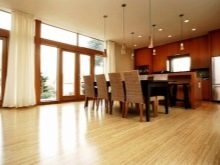

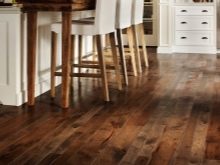
Marble
Natural marble is hardly a good choice for the kitchen. But under certain conditions, this material can be easily mounted in the interior of a room with high humidity. But marble easily absorbs dirt and is not resistant to acids. Material, especially in light colors, can quickly lose its original appeal. But if you carry out special processing in a timely manner, protecting the marble from moisture, you can easily use the magnificent natural stone in the interior of the kitchen.

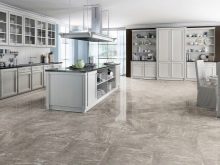

Wood
Natural wood is well suited for use in the design of the kitchen of a country house. In combination with walls made of logs, beams, clapboard sheathing, this material looks natural and attractive. Expensive and valuable types of wood are suitable for use in premium interiors. In the kitchen, a parquet board is usually laid with a lock joint or a sheet pile, coated with oil or varnish to increase moisture resistance.
A wooden floor is not very suitable for rooms with high humidity, temperature fluctuations. When the state of the environment changes, the natural material can swell, change its geometry, and crack. The protective cover will have to be regularly renewed to protect it from moisture and dirt. In addition, solid wood is difficult to combine with other materials.
Parquet flooring is even more capricious, it requires constant humidity and temperature, therefore it is not recommended for the kitchen.
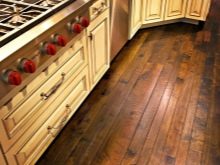
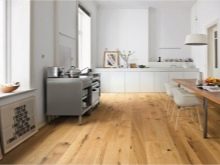

Tiled
Floor tiles can be ceramic, clay-based and porcelain stoneware, from composite materials. There are many advantages to this finish option. Decor can be found to suit every taste, style and budget. The tiled floor is the most practical, durable and reliable, not afraid of temperature extremes, moisture and pollution.
The coating can be matched with imitation of almost any material, laid in a checkerboard pattern or in other mounting options. The surface texture is also allowed to be different - glossy, semi-matt, matte. Such a floor is non-flammable and has a long service life.
In addition, porcelain stoneware is not afraid of mechanical or shock loads.
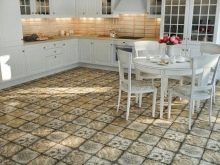

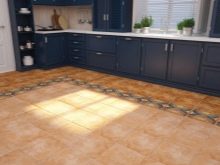
From laminate
Vinyl laminate is one of the most popular flooring options. The material is durable, practical, has a variety of decor, and is well suited for rooms with high levels of humidity. Such a floor is made by laying individual modules, requires a flat base, preliminary surface insulation. Multilayer laminate flooring, most often a mixture of PVC and quartz, it has a different classification. Suitable for the kitchen are 31-43 grades, semi-commercial and commercial, withstanding intense abrasion.
Depending on the version, the laminate for the floor can be:
- classic - with a textured top layer and a lock or a bottom part for gluing;
- self-adhesive - with a removable protective tape;
- contesse - with a predominantly castle-like setting, non-flammable, chemically resistant.
Rectangular vinyl flooring panels most often mimic the texture and colors of natural wood. Square ones make them look like natural stone.
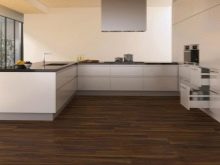
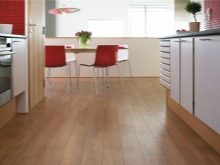
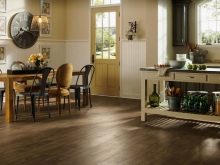
Types of structures
When creating a floor in a kitchen, it is very important to consider what type of construction will be created in the interior. If only one room is finished, you can do without the formation of additional architectural elements.The simplest option is a single-level floor, which has an equal height over the entire kitchen area. It is laid on a flat cement screed or poured according to the selected technology.
A two-level floor is a good solution for combined rooms. Kitchen-living room or kitchen-dining room can be zoned using a modern podium. But to create it in the interior, it is very important to take into account the initial parameters of the room. You should not make multi-level floors in kitchens with a ceiling height of less than 2.7 m.In addition, the height of the podium itself should be no more than 150-170 mm, for it you will have to fill in an additional screed or make another base, form a soundproof layer, calculate the change in loads on surface.
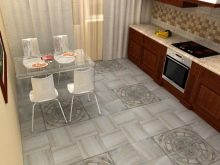
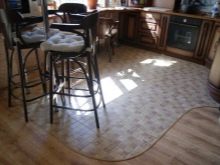
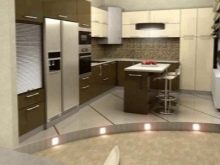
Color solution
When choosing a color scheme for the floor in the interior of the kitchen, it is very important to follow certain rules. First of all, you will have to decide whether it will be contrasting or to match the rest of the interior elements. If you want unusual effects, you can use a transparent kitchen floor with a 3D effect or original photo printing.
The simplest solution is off-the-shelf print media with a clear top in the dining area. But it is not recommended to place it in close proximity to work surfaces and sources of fire. Monochrome self-leveling floors look somewhat defiant and are combined with high-tech or modern style, but it is better to choose laconic black, white, gray solutions.

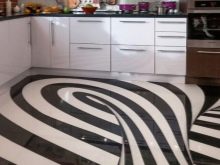
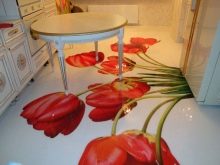
When choosing a color scheme, it is recommended to consider the following recommendations.
- Light colors reflect light well and help to visually expand the interior space. But in a room with a white headset, it can create an unnecessary feeling of monotony, facelessness. In addition, in the kitchen, a light floor is not very practical to use.
- Dark tones create a bright contrast, serve as an accent in the interior. They are more convenient to use in the kitchen, but require good lighting.
- Bright juicy colors well emphasize geometric solutions in the setting. They can be supported by stretch ceilings and effectively highlight the podium structure. Tiled floors in vibrant colors look good in a country kitchen or avant-garde interior. Self-leveling juicy, green, blue, yellow floors look spectacular, they go well with the atmosphere of a light, spacious kitchen in eco-style.
- Pastel shades are used mainly in kitchen finishes with natural materials. Wood, marble, tiles look quite impressive here, without being striking.
The choice of floor color is recommended taking into account the shade of the headset, walls, ceiling and design style.
Only in this case you can get a truly harmonious interior solution.
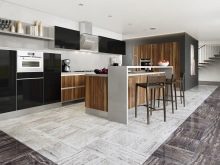

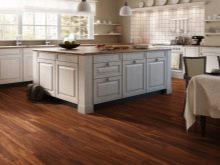
Design
Among the most fashionable design options for the kitchen floor the following solutions can be distinguished:
- 3D with visual effects;
- in a cage - with checkerboard styling and contrasting panels;
- natural and eco-friendly, wood, stone;
- with the effect of aging, brushing, highlighting;
- in glossy monochrome design (bulk or tiled);
- in a patchwork style, reminiscent of a patchwork quilt;
- made of cork while preserving the natural texture;
- with geometric patterns in the art deco style;
- under bare concrete, which is typical for a loft;
- with floral ornaments;
- with 2D photo printing (bulk).
These and other fashionable design options look interesting and stylish in the design of the kitchen, they allow you to bring novelty or a feeling of coziness and comfort to the interior.
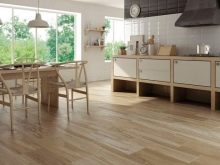

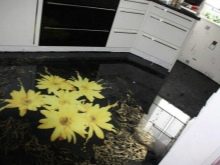
How to choose?
When choosing a material for finishing the floor in the interior of the kitchen the following points must be considered.
- Number of storeys of the building. In an apartment on the ground floor and in a country house, the base of the floor will require more complex work, additional thermal insulation. It is better to use natural materials here - wood or cork.
- Practicality. Ease of cleaning is an important advantage when it comes to kitchen finishing materials.
- Moisture resistance. The kitchen floor should not absorb moisture. All other options are best left for living quarters.
- Durability. The service life of the material means a lot, especially if complex repairs are being made with the construction of a podium or the combination of a living room and a kitchen.
- Repair budget. If you don't have much money to finish the kitchen floor, you can consider laying linoleum or ceramic tiles.

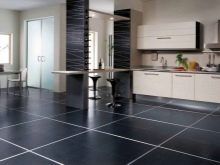
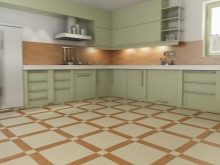
Beautiful ideas
- A good example of combining tiles and laminate in a kitchen interior. The coverage boundary runs along the level of division of functional zones.
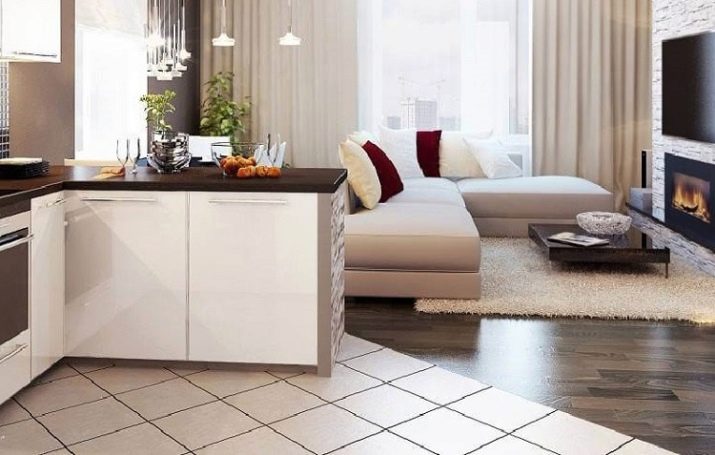
- Stylish self-leveling floor with floral patterns. A sophisticated and practical solution for modern kitchens.

- Bamboo flooring in the kitchen is an unusual and at the same time traditional finish.

You can learn how to make a kitchen floor with your own hands from the video below.


